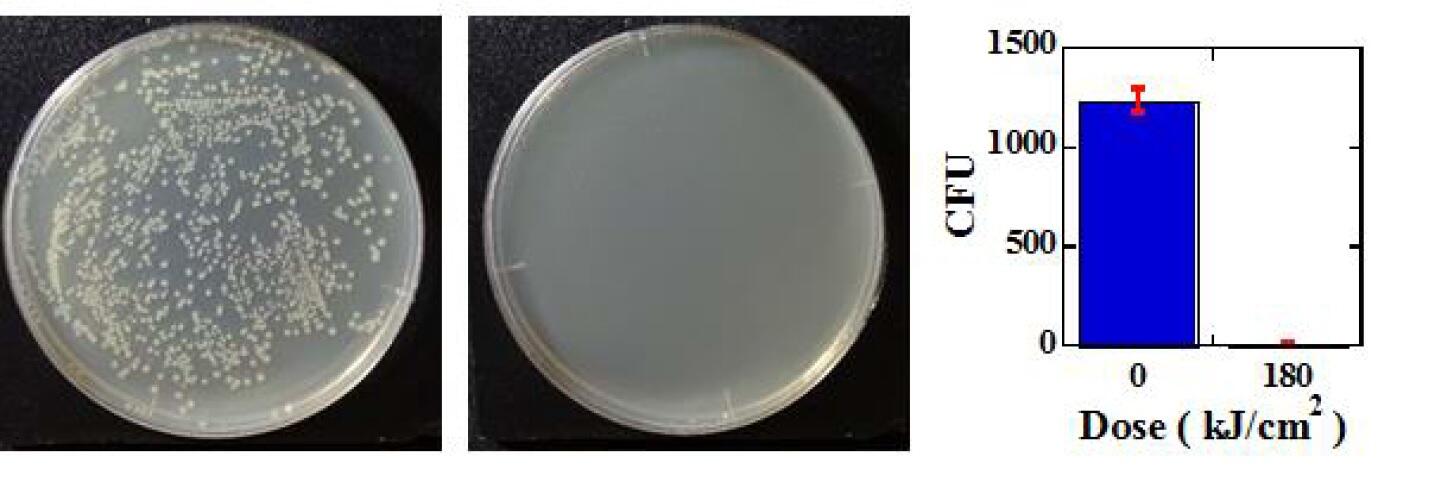
Provided by Nagoya City University
The collaborative research group comprising Lecturer Ichiro Tatsuno and Professor Tadao Hasegawa of the Graduate School of Medical Sciences, Professor Takahiro Matsumoto of the Graduate School of Design and Architecture, and colleagues at Nagoya City University was the first to demonstrate that irradiation with visible pulsed light can efficiently sterilize bacteria and viruses. Irradiation with visible pulsed light is expected to be developed as new technology for safe and easy sterilization of various pathogenic viruses and bacteria and could replace ultraviolet sterilization. Their findings were published in Scientific Reports.
It has been reported that ultraviolet light (UVC) can sterilize pathogenic viruses and bacteria, but UVC use is limited as it can be easily absorbed by human cells and proteins, leading to skin cancer and other diseases. On the other hand, visible light is not harmful, but it usually exerts no sterilizing effect when used for irradiating viruses and bacteria.
The research group discovered that instantaneous irradiation with highly bright visible light (like strobe flash lights) even for nanoseconds can efficiently inactivate viruses and bacteria, and demonstrated its effectiveness using a unique newly-developed sterilizer with a wavelength-tunable nanosecond pulsed laser.
Bacteria and viruses can efficiently absorb light of certain wavelength s in the visible light spectrum. This feature is particularly prominent in pigmented bacteria such as Pseudomonas aeruginosa and Staphylococcus aureus. The research group used a wavelength-tunable pulsed laser to generate light with a spectral component matching the wavelengths at which light is efficiently absorbed by microbes. They found that instantaneous irradiation (a few nanoseconds) of bacteria and viruses with highly bright light inactivated small bacteria and viruses by raising their temperature above 300 °C, without significantly increasing the temperature of large cells, such as human cells. This method was developed by integrating physics and biology via incorporating resonance excitation into the technique of sterilizing pathogenic viruses and bacteria.
The research group used gold nanoparticles when treating bacteria and viruses and measured the increase in their temperature upon irradiation with a nanosecond wavelength-tunable pulsed laser sterilizer. They found that gold nanoparticles absorbed pulsed laser light and instantly reached a temperature above 1000 °C, causing the gold nanoparticles to melt, while the temperature of the solution increased only by approximately 2 °C. Also, irradiation of E. coli colonies with the sterilizer successfully reduced their count by 99.99 %.
The research group aims to advance the research and development of the visible pulsed light sterilization technology for safely inactivating not only E. coli, but also various pathogenic bacteria and viruses.
It is expected to become a novel photo-disinfection technology that can safely and easily sterilize various pathogenic viruses and bacteria circulating in a given room without using ultraviolet light that is harmful for the human body.
In addition, as pulsed flash light of highly-bright visible light can be easily constructed using semiconductor light emitting diode (LED) technology, it can be developed into hybrid lighting fixtures, wherein LED device is equipped with pulsed flash sterilization light.
This article has been translated by JST with permission from The Science News Ltd.(https://sci-news.co.jp/). Unauthorized reproduction of the article and photographs is prohibited.




